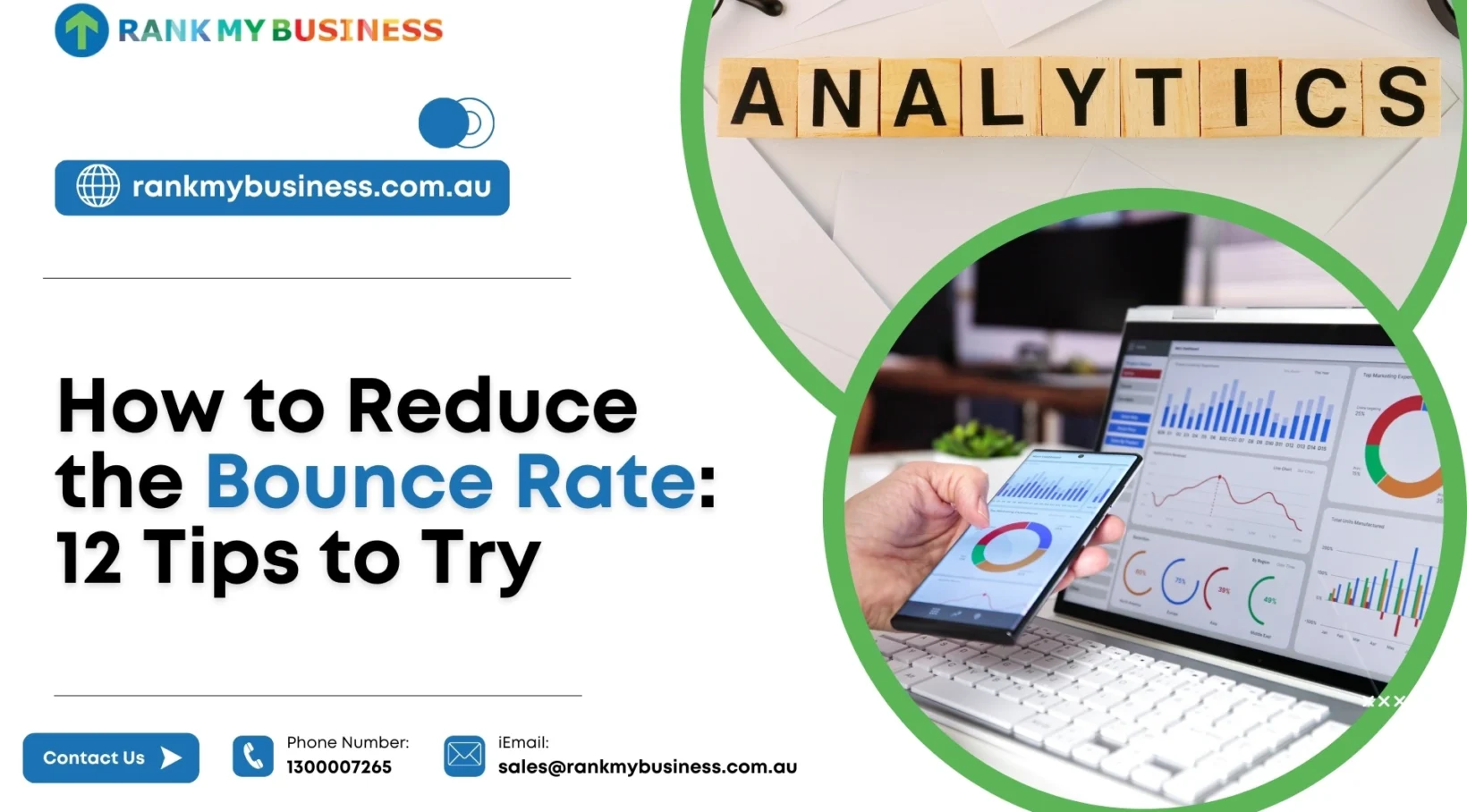We’ve all been there. You visit a website, and within a few seconds, you hit the back button. The site didn’t load quickly enough, the design felt outdated, or the content just didn’t match your needs. This behaviour contributes to what is known as a “bounce rate,” a crucial metric for website owners to monitor. If you’re wondering how to improve your website’s performance and keep visitors on your pages longer, you’re in the right place. This guide will dive into practical strategies to reduce bounce rates and ultimately improve the user experience.
What is Bounce Rate?
Bounce rate refers to the percentage of visitors who land on your website and leave without interacting with it further—whether they view other pages, click on links, or spend significant time on the page. A high bounce rate typically indicates that visitors aren’t finding what they’re looking for or that your site is difficult to navigate.
Why Reduce the Bounce Rate?
A high bounce rate is a clear sign that your website might be underperforming in key areas like user experience, content quality, or page speed. By reducing bounce rates, you can boost engagement, increase conversions, and enhance overall website performance. But reducing your bounce rate is not just about the numbers. It’s about ensuring your visitors find your site valuable and engaging enough to stick around.
What is a Good Bounce Rate?
There’s no one-size-fits-all answer to what constitutes a “good” bounce rate, as it can vary by industry and type of website. However, generally speaking:
- A bounce rate between 26% and 40% is considered excellent.
- 41% to 55% is average.
- 56% to 70% means your site might need improvement.
- Over 70% could indicate significant issues.
The goal should be to lower your bounce rate to a level that signifies visitors are engaging with your content and exploring what you have to offer.
12 Tips to Reduce Bounce Rate in Your Website
Now that you understand what bounce rate is and why it matters, let’s explore 12 actionable strategies to reduce your website’s bounce rate and keep your visitors engaged.
Try to Understand Why Visitors Are Leaving So Early
Before you can improve your website, you need to know why visitors are bouncing. Utilize analytics tools like Google Analytics to track user behaviour. Are people leaving quickly after a specific page? Is your content not relevant to what they expected? Understanding the reasons behind the high bounce rate is the first step to finding a solution.
Design a Better User Experience
User experience (UX) plays a crucial role in bounce rate. Ensure your website is visually appealing, easy to navigate, and user-friendly. Consider simplifying navigation menus, improving font readability, and reducing clutter. Visitors should easily find what they’re looking for within seconds of landing on your site.
Make Sure Your Website is Responsive
In today’s mobile-first world, having a website that works well on both desktop and mobile devices is crucial. A responsive website ensures that your content is easy to read and navigate, no matter what device your visitors are using. Google also rewards mobile-friendly sites with better rankings, so this is a win-win situation.
Include a Clear Call-to-Action
Visitors need to know what to do next after landing on your site. Whether it’s signing up for a newsletter, making a purchase, or downloading an eBook, a clear call-to-action (CTA) guides users through the journey. Make sure your CTAs stand out and are strategically placed throughout your website.
Build Some Landing Pages
Landing pages can help you capture visitor interest and provide relevant content that drives further engagement. Whether it’s a promotional page or a specific topic, landing pages can keep your audience engaged with targeted, actionable content.
Rethink Your Product Pages
If you’re running an eCommerce site or selling services, your product or service pages need to be optimized for conversion. High-quality images, detailed descriptions, and customer reviews can significantly impact bounce rates. Ensure that your product pages provide enough information to keep visitors intrigued.
Do Some A/B Testing
A/B testing allows you to experiment with different versions of a page to see which performs better. Test variations of headlines, CTAs, images, and even colour schemes to identify which elements lead to more engagement and lower bounce rates. Make data-driven decisions to optimize your site.
Engage Your Audience with Videos
Videos are a powerful tool for engagement. Studies show that users spend more time on sites that include video content. Whether it’s an explainer video, customer testimonial, or tutorial, incorporating videos into your site can increase time on the page and reduce bounce rates.
Plan Your Content Marketing Better
Quality content is at the heart of any successful website. Make sure your content aligns with the interests and needs of your audience. Use headlines and subheadings to break up text and make it easy to skim. Ensure that your content is well-researched, relevant, and engaging to keep visitors on your site longer.
Optimize Your Internal Linking Structure
Internal links help visitors discover more of your content and navigate your site more easily. By strategically linking to relevant articles or product pages within your content, you encourage users to explore further, thus reducing the chances of them bouncing off your site.
Use Interactive Content
Interactive elements like quizzes, surveys, polls, and calculators can significantly reduce bounce rates. These types of content keep users engaged and encourage them to interact with your site rather than leaving quickly. Interactive content also helps you gather valuable data about your audience.
Show Your Credibility
Visitors are more likely to stay on a site that appears trustworthy. Displaying customer testimonials, trust seals, security certificates, and media mentions can build credibility. The more your audience feels confident in your website, the longer they’ll stay and interact with your content.
Bounce Rate and SEO
Bounce rate isn’t just about user engagement—it’s also an important factor in search engine optimization (SEO). Here’s a breakdown of how bounce rate interacts with SEO and Google rankings.
Does Bounce Rate Affect Google Rankings?
While bounce rate is not a direct ranking factor, Google does consider user engagement when determining rankings. If visitors bounce quickly from your site, it may signal to Google that your content is not relevant or valuable. This can indirectly affect your rankings by lowering the perceived quality of your site.
Why Doesn’t Google Rank According to Bounce Rate?
Google doesn’t use bounce rate as a standalone ranking factor because it’s too vague. A high bounce rate may not always indicate poor quality—some visitors may find exactly what they need on a single page and leave satisfied. For instance, if someone visits your site, reads a blog post, and leaves, that might still be a positive outcome for them, even though they bounced.
How Does Bounce Rate Relate to SEO?
While not a direct ranking signal, bounce rate affects SEO indirectly by influencing user behaviour signals. A high bounce rate can lead to fewer interactions and lower engagement, which can harm your rankings over time. For businesses offering SEO Services in Melbourne, improving the bounce rate is especially crucial, as it helps increase user engagement and content relevance, both of which are vital for better SEO outcomes. Enhancing user experience, ensuring content relevance, and boosting engagement will naturally improve your SEO performance, benefiting your rankings in the long run.
Conclusion
Reducing your website’s bounce rate requires a multi-faceted approach. By focusing on improving user experience, creating high-quality content, and engaging your audience effectively, you can keep visitors on your site longer, boost conversions, and even improve your SEO performance. Keep testing, experimenting, and optimizing to ensure you’re offering the best possible experience for your users.
FAQs
What’s the average bounce rate for most websites?
The average bounce rate varies by industry, but a bounce rate between 41-55% is typical for most websites.
Does a high bounce rate mean poor website content?
Not necessarily. Sometimes, a high bounce rate can mean visitors find exactly what they need right away, even if they leave after viewing just one page.
How can I reduce my bounce rate without changing my content?
Improving website design, increasing page load speed, and ensuring mobile responsiveness are all key to reducing bounce rates, even without altering your content.
Is it possible to have a 0% bounce rate?
A 0% bounce rate is implausible, as some visitors will always leave quickly, especially if they find what they need right away.
How often should I monitor my bounce rate?
Monitoring your bounce rate regularly (weekly or monthly) is important to track improvements and spot potential issues early on.









 Back to blogs
Back to blogs
